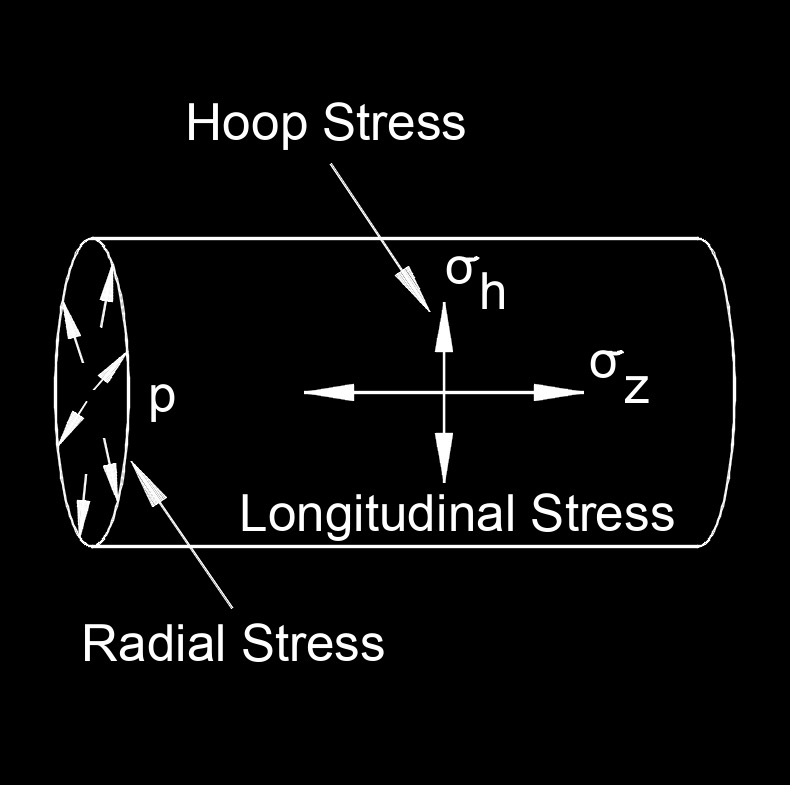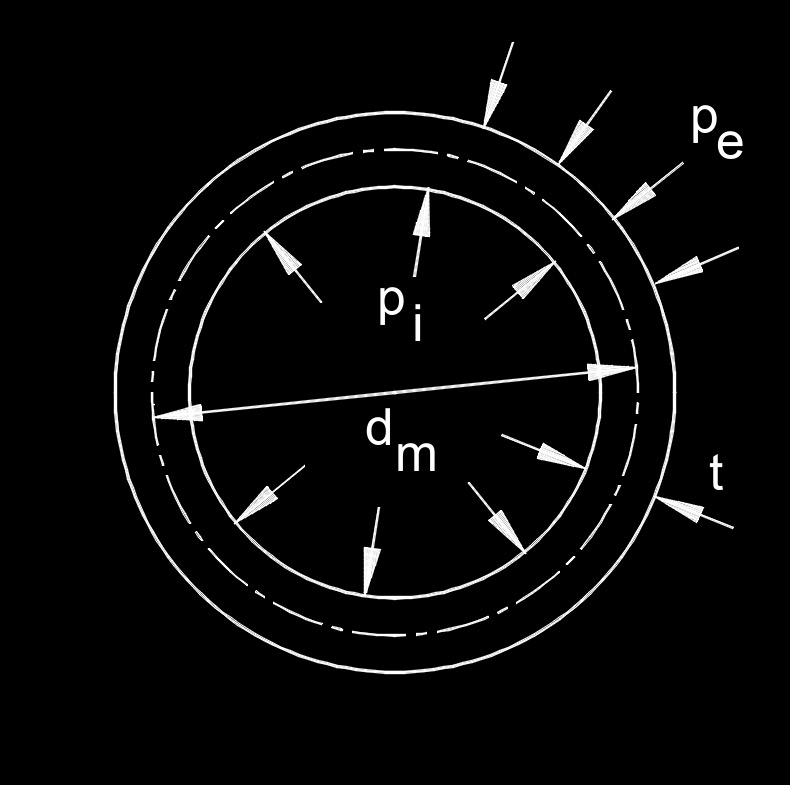Hoop Stress

 Hoop stress, abbreviated as \( \sigma_h \) (Greek symbol sigma), also called circumferential stress or tangential stress, is the circumferential and perpendicular stress to the axis imposed on a cylinder wall when exposed to an internal pressure load. This stress occurs in cylindrical or spherical structures subjected to internal or external pressure. It represents the stress that acts tangentially to the circumference of the structure.
Hoop stress, abbreviated as \( \sigma_h \) (Greek symbol sigma), also called circumferential stress or tangential stress, is the circumferential and perpendicular stress to the axis imposed on a cylinder wall when exposed to an internal pressure load. This stress occurs in cylindrical or spherical structures subjected to internal or external pressure. It represents the stress that acts tangentially to the circumference of the structure.
In the case of a cylindrical pressure vessel, such as a pipe or a tank, the hoop stress is the stress acting circumferentially around the wall of the cylinder. It is caused by the pressure difference between the inside and outside of the cylinder. Hoop stress is a critical parameter in the design and analysis of pressure vessels, as it helps determine the structural integrity and failure mechanisms associated with the vessel under pressure.
Factors and Conditions Affecting Pipe Wall Thickness
- Maximum conditions such as pressure and temperature
- Fluid properties
- Fluid velocity
- Pipe Materials
- Safety of design factors
Three Stresses that will Cause Failure in Pipe
- Axial stress \(h\)
- Hoop stress \(\theta\)
- Radial stress \(r\)
Understanding hoop stress is crucial for designing safe and reliable structures that can withstand internal pressure without rupturing or experiencing plastic deformation. Engineers and designers use these stress calculations to determine the appropriate wall thickness and material selection for such structures to meet safety and performance requirements.
Hoop Stress Factors
Hoop stress factors, also known as circumferential stress factors or stress concentration factors, are factors used in engineering and materials science to account for the increase in stress at specific locations in a structure or component. These factors are typically applied when analyzing the structural integrity of objects subjected to mechanical loads, such as tension, compression, or bending. Hoop stress factors are particularly important in situations where there are geometric irregularities or stress concentrations.
Where Hoop Stress Factors are Applied
Holes and Notches - When a hole or notch is present in a structure, it can create a stress concentration at the edge of the hole or notch. The hoop stress factor is used to calculate the maximum stress at these locations, which is typically higher than the nominal stress in the material.
Fillets and Corners - Sharp corners in a structure can also lead to stress concentrations. Fillets or rounded corners are often used to reduce these stress concentrations. Hoop stress factors help determine the stress reduction achieved by using fillets.
Changes in Cross-section - In structures with varying cross-sectional areas, the hoop stress factor can be used to calculate the maximum stress at locations where the cross-section changes abruptly, such as at a step or transition.
Pressure Vessels - In the context of pressure vessels like cylinders and pipes that carry fluids under pressure, hoop stress factors are crucial. The hoop stress factor helps calculate the maximum circumferential stress (hoop stress) in the vessel wall due to the internal pressure.
Bending - Hoop stress factors can also be used in the analysis of bending stress, particularly in thin walled structures like tubes or pipes subjected to bending loads.
It's important to note that hoop stress factors are specific to the geometry and loading conditions of the structure in question. Engineers and designers use mathematical formulas and stress analysis techniques to determine the appropriate hoop stress factors for their particular applications. These factors help ensure that the design of the structure can withstand the expected loads while minimizing the risk of failure due to stress concentrations.
Pressure vessel hoop stress factors, also called stress concentration factors or hoop stress intensification factors, are numerical values used to calculate the maximum circumferential stress in the wall of a pressure vessel. These factors are essential in the design and analysis of pressure vessels to ensure their structural integrity and safety, especially when subjected to internal pressure.
However, this formula assumes that the pressure vessel has a uniform, thin walled cylindrical geometry with no discontinuities or stress concentrations. In reality, most pressure vessels have features like nozzles, openings, and transitions that can cause stress concentrations, which lead to higher stresses than predicted by the simple formula.
To account for these stress concentrations and calculate the actual maximum hoop stress, engineers use hoop stress factors. These factors are typically denoted by the symbol 'K' and are specific to the geometry and configuration of the pressure vessel. They can be determined through analytical calculations, finite element analysis, or reference tables provided in codes and standards such as ASME Boiler and Pressure Vessel Code.
The value of 'K' depends on various factors, including the shape of the vessel, the presence of openings, the geometry of welds, and other design features. Engineers must select the appropriate hoop stress factor for their specific pressure vessel design to ensure it can safely handle the internal pressure without failure or excessive deformation. It's crucial to adhere to relevant codes and standards when designing and analyzing pressure vessels, as these documents provide guidelines and recommended values for hoop stress factors based on industry best practices and safety considerations.

